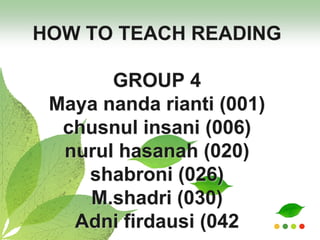
How to teach reading
- 1. HOW TO TEACH READING GROUP 4 Maya nanda rianti (001) chusnul insani (006) nurul hasanah (020) shabroni (026) M.shadri (030) Adni firdausi (042
- 2. Sempu Island If you like quiet place, where is no one around, isolated from the outside world, Sempu Island in Indonesia is the right place for you. The long journey to reach the lagoon in the heart of the island paid off after you see magnificent white sand and blue water. Population is zero, no electricity and no drinkable water, except one hidden oasis in the deep jungle. Where is it? Sempu Island is located in the south of East Java Province, the nearest big city is Malang in the north. It is an isolated island with a small sea-lagoon, where most people camp on the sand nearby. How to Get There? The most popular hub to reach this place is Malang City. There is a daily train to reach Malang from Jakarta with various accommodations; executive, business, or economy. You may find several drivers in Malang Central Station offering you a pick up to the nearest harbour. They will cost you no more than US$ 5, try to keep the price under that amount, as some drivers may give you higher price. In some cases, you will be transferred to other drivers in Turen Market, it may cost you more. Just make it sure with the driver. After you reach the island, you still need to walk for an hour through the muddy jungle. Follow the existing track or you might get lost, I did get lost, which doubled my journey’s time.
- 3. Why teach reading? •To be able to read texts in English. •Any exposure to English (provide students understands it more or less) is a good thing for language students. •Reading texts also provide good models for English writing. •Reading texts also provide opportunities to study language: vocabulary, grammar, punctuation, and the way we construct sentences, paragraphs and texts.
- 4. What kind of reading should students do? • The greatest controversy has centred on whether the texts should be ‘authentic’ or not. • A lot will depend on who the students are.
- 5. What reading skills should students acquire? • Students need to be able to scan the text for particular bits of information they are searching for. • Students need to be able to skim a text - as if they were casting their eyes over its surface - to get a general idea of what is about. • Reading for detailed comprehension. When looking for details, we expect students to concentrate on the minutiae of what they are reading.
- 7. 1. Reading is not passive skill. • Reading is an incredibly active occupation. We have to understand what the words mean.
- 8. 2. Students need to be engaged with what they are reading. • When they are really fired up by the topic or the task, they get much more from what is in front of them.
- 9. 3. Students should be encouraged to respond to the content of a reading texts, not just to the language. • It is important to study reading text for the way they use language, the number of paragraph they contain and how many times they use relative clauses.But the meaning, the message of the text, is just as important and we must give students a change to respond to that message in some way.
- 10. 4. Prediction is a major factor in reading. • When we read texts in our own language, we frequently have a good idea of the content before we actually read. Teachers should give students ‘hints’ so that they can predict what’s coming too. It will make them better and more engaged readers.
- 11. 5. Match the task to the topic. • Once a decision has been taken about what reading text the students are going to read, we need to choose good reading tasks – the right kind of questions, engaging, and useful puzzles etc.
- 12. 6. Good teachers exploit reading texts to the full. • Good teachers integrate the reading text into interesting class sequences, using the topic for discussion and further tasks, using the language for Study and later Activation.
- 13. What do reading sequences look like? Engaging studying Activate
- 14. Thank You...
